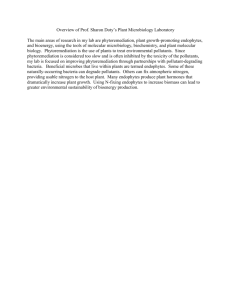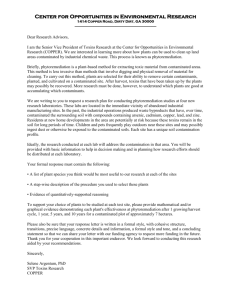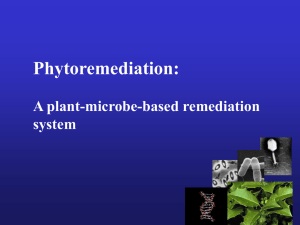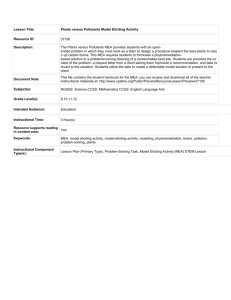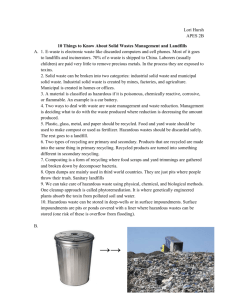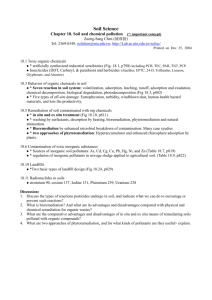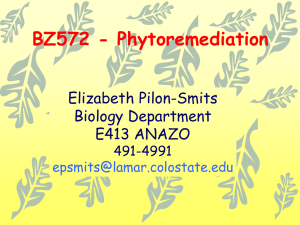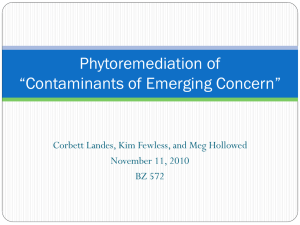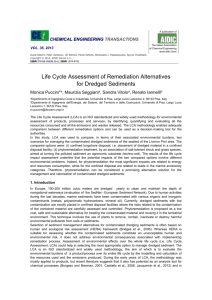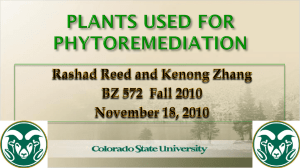Supplementary Table Recent selected examples of
advertisement
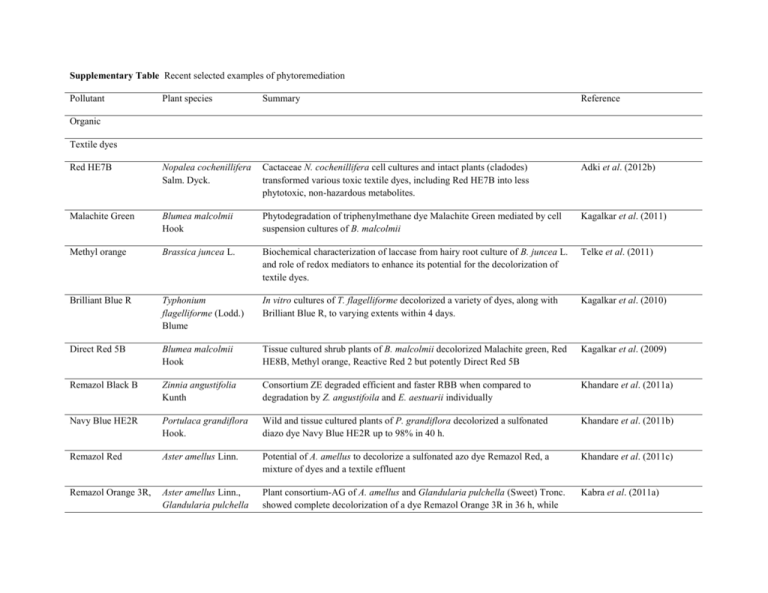
Supplementary Table Recent selected examples of phytoremediation Pollutant Plant species Summary Reference Red HE7B Nopalea cochenillifera Salm. Dyck. Cactaceae N. cochenillifera cell cultures and intact plants (cladodes) transformed various toxic textile dyes, including Red HE7B into less phytotoxic, non-hazardous metabolites. Adki et al. (2012b) Malachite Green Blumea malcolmii Hook Phytodegradation of triphenylmethane dye Malachite Green mediated by cell suspension cultures of B. malcolmii Kagalkar et al. (2011) Methyl orange Brassica juncea L. Biochemical characterization of laccase from hairy root culture of B. juncea L. and role of redox mediators to enhance its potential for the decolorization of textile dyes. Telke et al. (2011) Brilliant Blue R Typhonium flagelliforme (Lodd.) Blume In vitro cultures of T. flagelliforme decolorized a variety of dyes, along with Brilliant Blue R, to varying extents within 4 days. Kagalkar et al. (2010) Direct Red 5B Blumea malcolmii Hook Tissue cultured shrub plants of B. malcolmii decolorized Malachite green, Red HE8B, Methyl orange, Reactive Red 2 but potently Direct Red 5B Kagalkar et al. (2009) Remazol Black B Zinnia angustifolia Kunth Consortium ZE degraded efficient and faster RBB when compared to degradation by Z. angustifoila and E. aestuarii individually Khandare et al. (2011a) Navy Blue HE2R Portulaca grandiflora Hook. Wild and tissue cultured plants of P. grandiflora decolorized a sulfonated diazo dye Navy Blue HE2R up to 98% in 40 h. Khandare et al. (2011b) Remazol Red Aster amellus Linn. Potential of A. amellus to decolorize a sulfonated azo dye Remazol Red, a mixture of dyes and a textile effluent Khandare et al. (2011c) Remazol Orange 3R, Aster amellus Linn., Glandularia pulchella Plant consortium-AG of A. amellus and Glandularia pulchella (Sweet) Tronc. showed complete decolorization of a dye Remazol Orange 3R in 36 h, while Kabra et al. (2011a) Organic Textile dyes Green HE4B (Sweet) Tronc. individually A. amellus and G. pulchella took 72 and 96 h respectively. Glandularia pulchella (Sweet) Tronc. Phytoremediation ability of G. pulchella in degrading Green HE4B into nontoxic metabolites. Kabra et al. (2011b) Green HE4B Sesuvium portulacastrum Linn. Potential of Sesuvium for the efficient degradation of textile dyes and its efficacy on saline soils contaminated with toxic compounds. Patil et al. (2011) Reactive Red 198 Tagetes patula L. (Marigold) Degradation analysis of Reactive Red 198 by hairy roots of T. patula Patil et al. (2009) Acid orange 7 Phragmites australis (Cav.) Trin. ex Steud. The role of antioxidant and detoxification enzymes of P. australis (a subsurface vertical flow constructed wetland), in the degradation of acid orange7 Carias et al. (2008) The role of peroxidases extracted from the vertical flow constructed wetland P. australis leaves in the decolourization of Acid Orange 7 Carias et al. (2007) Integrated study of the role of P. australis in azo-dye treatment in a constructed wetland: From pilot to molecular scale. Davies et al. (2009) Phytoremediation of textile effluents containing azo dye by using Phragmites australis in a vertical flow intermittent feeding constructed wetland Davies et al. (2005) A constructed wetland model for synthetic reactive dye wastewater treatment by narrow-leaved cattails Nilratnisakorn et al. (2009) Synthetic reactive dye wastewater treatment by narrow-leaved cattails (T. angustifolia): Effects of dye, salinity and metals. Nilratnisakorn et al. (2007) Textile wastewater Typha angustifolia Linn. Polymeric dye R478 Mentha pulegium L. Peroxidase activity and phenolic content in elite clonal lines of M. pulegium in response to R-478 and Agrobacterium rhizogenes. Strycharz and Shetty (2001) Dye solutions of different colors Helianthus annuus L. Phytoremediation of textile dyes used as a scientific experiment or demonstration in teaching laboratories of middle school, high school and college students. Ibbini et al. (2009) Herbicides and pesticides Atrazine Metolachlor Panicum virgatum L. (switchgrass ) Phytoremediation capacity for detoxifying atrazine was found in the leaf biomass of switchgrass. Murphy and Coats (2011) Transgenic tobacco Transgenic tobacco plants expressing atzA exhibit resistance and strong ability to degrade atrazine. Wang et al. (2010) Vetiveria zizanioides (L.) Nash (Vetiver grass ) Vetiver grass studied for phytoremediation of heavy metals and organic wastes. Danh et al. (2009) Lolium multiflorum Lam. (ryegrass) Phytoremediation potential of the novel atrazine tolerant L. multiflorum and studies on the mechanisms involved. Merini et al. (2009) a mixture of prairie grasses Fate of atrazine in a grassed phytoremediation system was found by using radiolabelled atrazin. Henderson et al. (2007a) Oryza sativa L.(rice plants ) The ability of transgenic rice plants (pIKBACH) to remove atrazine and metolachlor from soil was confirmed in large-scale experiments. Kawahigashi et al. (2006) three species of poplar tree Phytoremediation of atrazine by poplar trees: toxicity, uptake, and transformation. Chang et al. (2005) Brassica juncea CG, Lindblom SD, Smits EA. Overexpression of enzymes involved in glutathione synthesis enhances tolerance to organic pollutants in Brassica juncea. Flocco et al. (2004) Prairie grasses Mass balance of metolachlor in a grassed phytoremediation system. Henderson et al. (2007b) Oryza sativa L. (rice plants ) The human cytochrome P450 gene CYP2B6 was introduced into rice plants, and the CYP2B6-expressing rice plants became more tolerant to various herbicides than nontransgenic Nipponbare rice plants. Kawahigashi et al. (2005) Arabidopsis thaliana (L.) Heynh Gene expression and microscopic analysis of Arabidopsis exposed to chloroacetanilide herbicides and explosive compounds Mezzari et al. (2005) Glyphosate Lemna minor L. Potential use of L. minor for the phytoremediation of isoproturon and glyphosate Dosnon-Olette et al. (2011) Diphenyl ether and chloroacetanilide transgenic Nicotiana tabacum L. (tobacco plants) Overexpression of a specific soybean GmGSTU4 isoenzyme improves diphenyl ether and chloroacetanilide herbicide tolerance of transgenic tobacco plants Benekos et al. (2010) Glufosinate Zea mays L. , Brassica napus L. Distribution and metabolism of D/L-, L- and D-glufosinate in transgenic, glufosinate-tolerant crops of maize and oilseed rape. Ruhland et al. (2004) Endosulfan Brassica campestris Linn., Zea mays L. The phytoextraction potential of mustard and maize to remove a organochlorine pesticide endosulfan was investigated. Mukherjee and Kumar (2011) Carbendazim, octhilinone, diuron Blumea malcolmii Hook Detoxification of a carcinogenic paint preservative by Blumea malcolmii Hook cell cultures Adki et al. (2011) Arabidopsis thaliana (L.) Heynh Arabidopsis plants have engineered to degrade RDX, whilst withstanding the phytotoxicity of TNT Rylott et al. (2011) the potential role of upregulated genes in Arabidopsis plant metabolism, phytoremediation, and phytosensing Rao et al. (2009) TNT Arabidopsis plants overexpressing OPR1 removed TNT more quickly from liquid culture, produced increased levels of transformation products, and maintained higher fresh weight biomasses than wild-type plants. Beynon et al. (2009) 2,6-dinitrotoluene (2,6-DNT) Phytotoxicity and phytoremediation of 2,6-dinitrotoluene using Arabidopsis plant Yoon et al. (2007) Phytotransformation of 2,4-dinitrotoluene in Arabidopsis.: toxicity, fate, and Yoon et al. (2006) Nitroaromatics and explosives 2,4,6-trinitrotoluene (TNT) and hexahydro-1,3,5trinitro-1,3,5-triazine (RDX) gene expression studies in vitro. TNT Vetiveria zizanioides L. (vetiver grass ) Vetiver grass is capable of removing TNT from soil in the presence of urea. Das et al. (2010) The efficiency of vetiver grass in removing TNT from aqueous media was explored in the presence of a common agrochemical, urea, used as a chaotropic agent. Makris et al. (2007) Enhanced transformation of TNT by tobacco plants expressing a bacterial nitroreductase. Hannink et al. (2007) The transgenic tobacco plants overexpressing a bacterial nitroreductase gene detoxify soil contaminated with the high explosive 2,4,6-trinitrotoluene (TNT), with a significantly increased microbial community biomass and metabolic activity in the rhizosphere of transgenic plants compared with wild type plants. Travis et al. (2007) Rumex crispus L. Phytoremediation of soil contaminated with cadmium and/or TNT. Baek et al. (2006) Phenanthrene, pyrene, and benzo[a]pyrene Oryza sativa . (rice) Evaluating the spatial dissipation gradient of PAHs, including phenanthrene, pyrene, and benzo[a]pyrene in rice rhizosphere, with various bioavailability represented with sequential extraction. Ma et al. (2012) Phenanthrene, pyrene, and benzo[a]pyrene Bouteloua curtipendula (Michx.) Torr (side oats grama ) Phytoremediation and removal mechanisms in B. curtipendula growing in sterile hydrocarbon spiked cultures Reynoso-Cuevas et al. (2011) Study of PAH dissipation and phytoremediation in soils: comparing freshly spiked with weathered soil from a former coking works. Smith et al. (2011) Evaluation of the phytoremediation potential of four plant species for Wang and Oyaizu (2009) Nicotiana tabacum L.(tobacco ) Polycyclic aromatic hydrocarbons (PAH) Dibenzofuran Cynodon dactylon (L.) Pers (bermuda grass ), Agrostis palustris Huds. (bent grass ), Zoysia japonica (lawn grass ), and, Trifolium repens L. (white clover ) dibenzofuran-contaminated soil. Perennial weed species Phytoextraction and uptake patterns of weathered polychlorinated biphenylcontaminated soils using three perennial weed species. Ficko et al. (2011a) Pumpkin and weed species Effect of pumpkin root exudates on ex situ polychlorinated biphenyl (PCB) phytoextraction by pumpkin and weed species. Ficko et al. (2011b) Salix alaxensis L. (felt-leaf willow) and Picea glauca (white spruce) Assessing the potential for rhizoremediation of PCB contaminated soils in northern regions using native tree species. Slater et al. (2011) Alfalfa Influence of arbuscular mycorrhiza and Rhizobium on phytoremediation by alfalfa of an agricultural soil contaminated with weathered PCBs: a field study. Teng et al. (2010) Alfalfa, Ryegrass, Tall fescue and Rice Beta-cyclodextrin enhanced phytoremediation of aged PCBs-contaminated soil from e-waste recycling area. Chen et al. (2010a) Chenopodium album L., Vicia cracca L., Cirsium vulgare (Savi) Ten., Solidago canadensis L. Potential for phytoextraction of PCBs from contaminated soils using weeds. Ficko et al. (2010) Cucurbita pepo L. (pumpkin ) Effect of plant age on PCB accumulation by pumpkin Low et al. (2009) Polychlorinated biphenyls Halogenated hydrocarbons 2,4-Dichlorophenol (2,4-DCP) Nicotiana tabacum L. (tobacco ) Tobacco hairy roots efficiently transformed high concentrations of 2,4-DCP in the medium to products with the lignin-type nature, which compartmentalized in hairy root cell walls. Talano et al. (2010) Crambe abyssinica Hochst Identifying genes and gene networks involved in chromium metabolism and detoxification in Crambe abyssinica. Zulfiqar et al. (2011) Spirodela polyrrhiza Phytoremediation of Cr(VI) by Spirodela polyrrhiza (L.) Schleiden employing reducing and chelating agents. Bala and Thukral (2011) Oryza sativa L. (rice ), paragrass (Brachiaria mutica), and Eichhornia crassipes (aquatic weed ) Bio-concentration of chromium-an in situ phytoremediation study at South Kaliapani chromite mining area of Orissa, India. Mohanty et al. (2012) Ipomonea aquatica L. (water spinach ) Phytoremediation of Cr(III) by I. aquatica from water in the presence of EDTA and chloride. Chen et al. (2010b) Hybrid willows Effect of temperature on phytoextraction of hexavalent and trivalent chromium by hybrid willows Yu et al. (2010) Inorganic (metals and metalloids) Chromium Arsenic Hydrilla verticillata (L.f.) Royle The accumulation of As in the shoot and immobilization of As below ground in roots proved H. verticillata as a potential As phytofiltrator for bioremediation. Xue and Yan (2011) Zea mays L. (maize ) Identification of QTLs for arsenic accumulation in maize using a RIL population. Ding et al. (2011) Pityrogramma calomelanos L. and Pteris vittata L. Phytoremediation potential of P. calomelanos var. austroamericana and P. vittata L. grown at a highly variable arsenic contaminated site. Niazi et al. (2011) Hyacinth Batch and continuous removal of arsenic using hyacinth roots. Govindaswamy et al. (2011) Cottonwood Enhanced arsenic tolerance of transgenic eastern cottonwood plants expressing gamma-glutamylcysteine synthetase. LeBlanc et al. (2011) Alyssum species. Cadmium phytoextraction potential of different Alyssum species. Barzanti et al. (2011) Ricinus communis L. The phytoremediation potential of bioenergy crop R. communis for DDTs and cadmium co-contaminated soil Huang et al. (2011) Solanum nigrum L. In-situ cadmium phytoremediation using S. nigrum L.: the bio-accumulation characteristics trail. Ji et al. (2011) Arabidopsis thaliana (L.) Heynh Heterologous expression of a N. nucifera phytochelatin synthase gene enhances cadmium tolerance in A. thaliana. Liu et al. (2011) Expression of the bacterial heavy metal transporter MerC fused with a plant SNARE, SYP121, in A. thaliana increases cadmium accumulation and tolerance. Kiyono et al. (2011) Chemical-assisted phytoremediation of CD-PAHs contaminated soils using S. nigrum L. Yang et al. (2011) Cadmium Solanum nigrum L. Selenium Stanleya pinnata (Pursh) Britton The salt/B tolerant S. pinnata genotypes selected represent a promising new tools for the successful phytoremediation of Se from salt/B and Se-laden agricultural drainage sediments Freeman and Bañuelos (2011) Canola, Mustard, Broccoli, Spearmint, Sugarcane, Guar, Wheat, and Poplar Developing a sustainable phytomanagement strategy for excessive selenium in western United States and India. Bañuelosm and Dhillon (2011) Impatiens walleriana Hook. f. Mercury uptake and translocation in I. walleriana plants grown in the contaminated soil from Oak Ridge. Pant et al. (2011) ----------------- Metallothionein expression in chloroplasts enhances mercury accumulation and phytoremediation capability. Ruiz et al. (2011) Atriplex codonocarpa Paul G.Wilson, Austrodanthonia caespitosa (Gaudich.) H.P.Linder and Vetiveria zizanioides L. Chelate-assisted phytoextraction of mercury in biosolids. Lomonte et al. (2011) Chlamydomonas reinhardtii P.A.Dang. Removal of mercury from sediment by ultrasound combined with biomass (transgenic C. reinhardtii). He et al. (2011) Calendula alata Rech. f., Chenopodium album L., Amaranthus chlorostachys Phytoremediation of stable Cs from solutions by C. alata, A. chlorostachys and C. album. Moogouei et al. (2011) Mercury Cesium Sorghum hybrid and Trifolium pratense L. Using elevated CO2 to increase the biomass of a S. vulgare x S. vulgare var. sudanense hybrid and T. pratense L. and to trigger hyperaccumulation of cesium. Wu et al. (2009) Chromolaena odorata (L.) King & H.E. Robins. Potential of C. odorata for phytoremediation of (137)Cs from solution and low level nuclear waste. Singh et al. (2009) Sunflower Copper phytoextraction in tandem with oilseed production using commercial cultivars and mutant lines of sunflower. Kolbas et al. (2011) Marigold The effect of the symbiosis between Tagetes erecta L. (marigold) and Glomus intraradices in the uptake of Copper(II) and its implications for phytoremediation. Castillo et al. (2011) Perennial peanut Potential phytoextraction and phytostabilization of perennial peanut on coppercontaminated vineyard soils and copper mining waste. Andreazza et al. (2011) Physalis alkekengi L. Zinc accumulation and synthesis of ZnO nanoparticles using P. alkekengi L. Qu et al. (2011) Buttonwood Phytoremediation of lead in urban polluted soils in the north of Iran Hashemi (2012) Willow varieties The pot experiment suggested that Salix varieties have the potential to take up and translocate significant amounts of Pb into above-ground tissues using EDTA. Zhivotovsky et al. (2011) Brassica napus L. (rape shoots ) Nickel accumulation in rape shoots (B. napus L.) increased by putrescine. Shevyakova et al. (2011) Copper Zinc Lead Nickel Miscellaneous Fe, Cu, Zn, Ni, Al, Cr, Pb, Si, and As Pteris vittata L. P. vittata is confirmed to be a heavy metals accumulator and a highly suitable candidate for phytoremediation of metal contaminated wastelands. Kumari et al. (2011) Cd, Cr, Cu, Mn, Fe, Ni, Pb and Zn Phragmites cummunis (Cav.) Trin. ex Steud., Typha angustifolia L., Cyperus esculentus L. Phytoremediation of Cd, Cr, Cu, Mn, Fe, Ni, Pb and Zn from aqueous solution using Phragmites, Typha and Cyperus. Chandra and Yadav (2011) Pb, Cr and Mn Typha latifolia L. and Scirpus americanus (Pers.) Volkart ex Schinz & R. Keller Lead, chromium and manganese removal by in vitro root cultures of two aquatic macrophytes species. Santos-Díaz Mdel and Barrón-Cruz Mdel (2011) Cu, Ni and Cr rapeseeds, sunflowers, tomatoes, and soapworts Combined mild soil washing and compost-assisted phytoremediation in treatment of silt loams contaminated with copper, nickel, and chromium. Sung et al. (2011) Cr and Cd Prosopis laevigata (Humb. & Bonpl. ex Willd.) M.C.Johnst P. laevigata a potential chromium (VI) and cadmium (II) hyperaccumulator desert plant. Buendía-González et al. (2010) Pb, Zn, Fe and Cr Eichhornia crassipes (Mart.) Solms, Hydrilla verticillata L. f. Royle Evaluation of uptake rate of heavy metals by two macrophytes Eichhornia (free-floating) and Hydrilla (submerged). Dixit and Dhote (2010) Zn, Pb, and Cd Inula viscosa (L.) Greuter, Euphorbia dendroides L., and Poa annua L., Arundo donax L, Cistus salvifolius L. and Hyacinthoides italica Uptake of heavy metals by native species growing in a mining area in Sardinia, Italy: discovering native flora for phytoremediation Barbafieri et al. (2011) (L.) Chouard ex Roth m. Supplementary Table References Kagalkar AN, Jagtap UB, Jadhav JP, Govindwar SP, Bapat VA (2010) Studies on phytoremediation potentiality of Typhonium flagelliforme for the degradation of Brilliant Blue R. Planta 232: 271-285. Kagalkar AN, Jadhav MU, Bapat VA, Govindwar SP (2011) Phytodegradation of the triphenylmethane dye Malachite Green mediated by cell suspension cultures of Blumea malcolmii Hook. Bioresource Technol 102(22):10312-8. Telke AA, Kagalkar AN, Jagtap UB, Desai NS, Bapat VA, Govindwar SP (2011) Biochemical characterization of laccase from hairy root culture of Brassica juncea L. and role of redox mediators to enhance its potential for the decolorization of textile dyes. Planta 234: 1137-1149. Khandare RV, Kabra AN, Kurade MB, Govindwar SP (2011a) Phytoremediation potential of Portulaca grandiflora Hook. (Moss-Rose) in degrading a sulfonated diazo reactive dye Navy Blue HE2R (Reactive Blue 172). Bioresource Technol 102: 6774-6777. Khandare RV, Kabra AN, Tamboli DP, Govindwar SP (2011b) The role of Aster amellus Linn. in the degradation of a sulfonated azo dye Remazol Red: a phytoremediation strategy. Chemosphere 82: 1147-1154. Khandare RV, Rane NR, Waghmode TR, Govindwar SP (2011c) Bacterial assisted phytoremediation for enhanced degradation of highly sulfonated diazo reactive dye. Environ Sci Pollut Res 19(5):1709-18. Kabra AN, Khandare RV, Kurade MB, Govindwar SP (2011a) Phytoremediation of a sulphonated azo dye Green HE4B by Glandularia pulchella (Sweet) Tronc. (Moss Verbena). Environ Sci Pollut Res 18: 1360-1373. Kabra AN, Khandare RV, Waghmode TR, Govindwar SP (2011b) Differential fate of metabolism of a sulfonated azo dye Remazol Orange 3R by plants Aster amellus Linn., Glandularia pulchella (Sweet) Tronc. and their consortium. J Haz Mat 190: 424-431. Patil AV, Lokhande VH, Suprasanna P, Bapat VA, Jadhav JP (2011) Sesuvium portulacastrum (L.) L.: a potential halophyte for the degradation of toxic textile dye, Green HE4B. Planta 235: 1051-1063. Carias CC, Novais JM, Martins-Dias S (2008) Are Phragmites australis enzymes involved in the degradation of the textile azo dye acid orange 7? Bioresource Technol 99: 243-251. Davies LC, Cabrita GJM, Ferreira RA et al. (2009) Integrated study of the role of Phragmites australis in azo-dye treatment in a constructed wetland: From pilot to molecular scale. Ecol Eng 35: 961–970. Nilratnisakorn S, Thiravetyan P, Nakbanpote W (2007) Synthetic reactive dye wastewater treatment by narrow-leaved cattails (Typha angustifolia Linn.): Effects of dye, salinity and metals. Sci Total Environ 384: 67–76. Nilratnisakorn S, Thiravetyan P, Nakbanpote W (2009) A constructed wetland model for synthetic reactive dye wastewater treatment by narrow-leaved cattails (Typha angustifolia Linn.). Water Sci Technol 60: 1565–1574. Strycharz S and Shetty K (2002) Peroxidase activity and phenolic content in elite clonal lines of Mentha pulegium in response to polymeric dye R-478 and Agrobacterium rhizogenes. Process Biochem 37: 805–812. Ibbini JH, Davis LC, Erickson LE (2009) Phytoremediation in education: textile dye teaching experiments. Int J Phytoremediation 11: 451–462. Murphy IJ and Coats JR (2011) The capacity of switchgrass (Panicum virgatum) to degrade atrazine in a phytoremediation setting. Environ Tox Chem 30: 71522. Wang H, Chen X, Xing X, Hao X, Chen D (2010) Transgenic tobacco plants expressing atzA exhibit resistance and strong ability to degrade atrazine. Plant Cell Rep 29: 1391-1399. Wang Y and Oyaizu H (2009) Evaluation of the phytoremediation potential of four plant species for dibenzofuran-contaminated soil. J Haz Mat 168: 760-764. Danh LT, Truong P, Mammucari R, Tran T, Foster N (2009) Vetiver grass, Vetiveria zizanioides: a choice plant for phytoremediation of heavy metals and organic wastes. Int J Phytoremediation 11: 664-691. Merini LJ, Bobillo C, Cuadrado V, Corach D, Giulietti AM (2009) Phytoremediation potential of the novel atrazine tolerant Lolium multiflorum and studies on the mechanisms involved. Environ Pollut 157: 3059-3063. Henderson KL, Belden JB, Coats JR (2007a) Fate of atrazine in a grassed phytoremediation system. Environ Toxicol Chem 26: 1836-1842. Henderson KL, Belden JB, Coats JR (2007b) Mass balance of metolachlor in a grassed phytoremediation system. Environ Sci Technol 41: 4084-4089. Kawahigashi H, Hirose S, Ohkawa H, Ohkawa Y (2005) Phytoremediation of metolachlor by transgenic rice plants expressing human CYP2B6. J Agr Food Chem 53: 9155-9160. Kawahigashi H, Hirose S, Ohkawa H, Ohkawa Y (2006) Phytoremediation of the herbicides atrazine and metolachlor by transgenic rice plants expressing human CYP1A1, CYP2B6, and CYP2C19. J Agr Food Chem 54: 2985-2991. Chang SW, Lee SJ, Je CH (2005) Phytoremediation of atrazine by poplar trees: toxicity, uptake, and transformation. J Environ Sci Health B 40: 801-811. Flocco CG, Lindblom SD, Smits EA (2004) Overexpression of enzymes involved in glutathione synthesis enhances tolerance to organic pollutants in Brassica juncea. Int J Phytoremediation 6: 289-304. Mezzari MP, Walters K, Jelínkova M et al. (2005) Gene expression and microscopic analysis of Arabidopsis exposed to chloroacetanilide herbicides and explosive compounds. A phytoremediation approach. Plant Physiol: 858-869. Dosnon-Olette R, Couderchet M, Oturan MA, Oturan N, Eullaffroy P (2011) Potential use of Lemna minor for the phytoremediation of isoproturon and glyphosate. Int J Phytoremediation 13: 601-612. Ruhland M, Engelhardt G, Pawlizki K (2004) Distribution and metabolism of D/L-, L- and D-glufosinate in transgenic, glufosinate-tolerant crops of maize (Zea mays L ssp mays) and oilseed rape (Brassica napus L var napus). Pest Manage Sci 60: 691-696. Mukherjee I and Kumar A (2011) Phytoextraction of endosulfan a remediation technique. B Environ Contam Tox 88: 250-254. Rylott EL, Budarina MV, Barker A et al. (2011) Engineering plants for the phytoremediation of RDX in the presence of the co-contaminating explosive TNT. New Phytol 192: 405-413. Rao MR, Halfhill MD, Abercrombie LG et al. (2009) Phytoremediation and phytosensing of chemical contaminants, RDX and TNT: identification of the required target genes. Func Integr Gen 9: 537-547. Beynon ER, Symons ZC, Jackson RG et al. (2009) The role of oxophytodienoate reductases in the detoxification of the explosive 2,4,6-trinitrotoluene by Arabidopsis. Plant Physiol 151: 253-261. Yoon JM, Oliver DJ, Shanks JV 2006) Phytotransformation of 2,4-dinitrotoluene in Arabidopsis thaliana: toxicity, fate, and gene expression studies in vitro. Biotechnol Progress 22: 1524-1531. Yoon JM, Oliver DJ, Shanks JV (2007) Phytotoxicity and phytoremediation of 2,6-dinitrotoluene using a model plant, Arabidopsis thaliana. Chemosphere 68: 1050-1057. Das P, Datta R, Makris KC, Sarkar D (2010) Vetiver grass is capable of removing TNT from soil in the presence of urea. Environ Poll 158: 1980-1983. Makris KC, Shakya KM, Datta R, Sarkar D, Pachanoor D (2007) Chemically catalyzed uptake of 2,4,6-trinitrotoluene by Vetiveria zizanioides. Environ Pollut 148: 101-106. Hannink NK, Subramanian M, Rosser SJ et al. (2007) Enhanced transformation of TNT by tobacco plants expressing a bacterial nitroreductase. Int J Phytoremediation 9: 385-401. Travis ER, Hannink NK, Van der Gast CJ et al. (2007) Impact of transgenic tobacco on trinitrotoluene (TNT) contaminated soil community. Environ Sci Technol 41: 5854-5861. Baek KH, Chang JY, Chang YY et al. (2006) Phytoremediation of soil contaminated with cadmium and/or 2,4,6-trinitrotoluene. J Environ Biol 27: 311-316. Ma B, Wang J, Xu M et al. (2012) Evaluation of dissipation gradients of polycyclic aromatic hydrocarbons in rice rhizosphere utilizing a sequential extraction procedure. Environ Pollut 162C: 413-421. Reynoso-Cuevas L, Gallegos-Martínez ME, Cruz-Sosa F, Gutiérrez-Rojas M (2011) Phytoremediation and removal mechanisms in Bouteloua curtipendula growing in sterile hydrocarbon spiked cultures. Int J Phytoremediation 13: 613-25. Smith MJ, Flowers TH, Duncan HJ, Saito H (2011) Study of PAH dissipation and phytoremediation in soils: comparing freshly spiked with weathered soil from a former coking works. J Haz Mat 192: 1219-1225. Ficko SA, Rutter A, Zeeb BA (2011a) Effect of pumpkin root exudates on ex situ polychlorinated biphenyl (PCB) phytoextraction by pumpkin and weed species. Environ Sci Poll Res 18: 1536-1543. Ficko SA, Rutter A, Zeeb BA (2011b) Phytoextraction and uptake patterns of weathered polychlorinated biphenyl-contaminated soils using three perennial weed species. J Environ Qual 40: 1870-1877. Ficko SA, Rutter A, Zeeb BA (2010) Potential for phytoextraction of PCBs from contaminated soils using weeds. Sci Total Environ 408: 3469-3476. Slater H, Gouin T, Leigh MB (2011) Assessing the potential for rhizoremediation of PCB contaminated soils in northern regions using native tree species. Chemosphere 84: 199-206. Teng Y, Luo Y, Sun X et al. (2010) Influence of arbuscular mycorrhiza and Rhizobium on phytoremediation by alfalfa of an agricultural soil contaminated with weathered PCBs: a field study. Int J Phytoremediation 12: 516-533. Chen Y, Tang X, Cheema SA, Liu W, Shen C (2010a) Beta-cyclodextrin enhanced phytoremediation of aged PCBs-contaminated soil from e-waste recycling area. J Environ Monitor 12: 1482-1489. Chen JC, Wang KS, Chen H et al. (2010b) Phytoremediation of Cr(III) by Ipomonea aquatica (water spinach) from water in the presence of EDTA and chloride: effects of Cr speciation. Bioresource Technol 101: 3033-3039. Low JE, Whitfield AML, Rutter A, Zeeb BA (2009) Effect of plant age on PCB accumulation by Cucurbita pepo ssp. pepo. J Environ Qual 39: 245-250. Talano MA, Frontera S, González P, Medina MI, Agostini E (2010) Removal of 2,4-diclorophenol from aqueous solutions using tobacco hairy root cultures. J Haz Mat 176: 784–791. Zulfiqar A, Paulose B, Chhikara S, Dhankher OP (2011) Identifying genes and gene networks involved in chromium metabolism and detoxification in Crambe abyssinica. Environ Pollut 159: 3123-3128. Bala R, Thukral AK (2011) Phytoremediation of Cr(VI) by Spirodela polyrrhiza (L.) Schleiden employing reducing and chelating agents. Int J Phytoremediation 13: 465-491. Mohanty M, Pattnaik MM, Mishra AK, Patra HK (2012) Bio-concentration of chromium-an in situ phytoremediation study at South Kaliapani chromite mining area of Orissa, India. Environ Monit Assess 184: 1015-1024. Yu XZ, Peng XY, Xing LQ (2010) Effect of temperature on phytoextraction of hexavalent and trivalent chromium by hybrid willows. Ecotoxicology 19: 61-68. Xue PY and Yan CZ (2011) Arsenic accumulation and translocation in the submerged macrophyte Hydrilla verticillata (L.f.) Royle. Chemosphere 85: 11761181. Ding D, Li W, Song G et al. (2011) Identification of QTLs for arsenic accumulation in maize (Zea mays L.) using a RIL population. PLoS One 6: e25646. doi:10.1371/journal.pone.0025646 Niazi NK, Singh B, Van Zwieten L, Kachenko AG (2011) Phytoremediation potential of Pityrogramma calomelanos var. austroamericana and Pteris vittata L. grown at a highly variable arsenic contaminated site. Int J Phytoremediation 13: 912-32. Govindaswamy S, Schupp DA, Rock SA (2011) Batch and continuous removal of arsenic using hyacinth roots. Int J Phytoremediation 13: 513-527. LeBlanc MS, Lima A, Montello P et al. (2011) Enhanced arsenic tolerance of transgenic eastern cottonwood plants expressing gamma-glutamylcysteine synthetase. Int J Phytoremediation 13: 657-673. Barzanti R, Colzi I, Arnetoli M et al. (2011) Cadmium phytoextraction potential of different Alyssum species. J Haz Mat 196: 66-72. Huang H, Yu N, Wang L et al. (2011) The phytoremediation potential of bioenergy crop Ricinus communis for DDTs and cadmium co-contaminated soil. Bioresource Technol 102: 11034-11038. Ji P, Song Y, Sun T et al. (2011) In-situ cadmium phytoremediation using Solanum nigrum L.: the bio-accumulation characteristics trail. Int J Phytoremediation 13: 1014-1023. Yang C, Zhou Q, Wei S, Hu Y, Bao Y (2011) Chemical-assisted phytoremediation of CD-PAHs contaminated soils using Solanum nigrum L. Int J Phytoremediation 13: 818-833. Liu Z, Gu C, Chen F et al. (2011) Heterologous expression of a Nelumbo nucifera phytochelatin synthase gene enhances cadmium tolerance in Arabidopsis thaliana. Appl Biochem Biotech 166: 722-734. Kiyono M, Oka Y, Sone Y et al. (2011) Expression of the bacterial heavy metal transporter MerC fused with a plant SNARE, SYP121, in Arabidopsis thaliana increases cadmium accumulation and tolerance. Planta 235: 841-850. Freeman JL, Bañuelos GS (2011) Selection of salt and boron tolerant selenium hyperaccumulator Stanleya pinnata genotypes and characterization of Se phytoremediation from agricultural drainage sediments. Environ Sci Technol 45: 9703-9710. Bañuelos GS, Dhillon KS (2011) Developing a sustainable phytomanagement strategy for excessive selenium in western United States and India. Int J Phytoremediation 13 Suppl 1:208-28. Pant P, Allen M, Tansel B (2011) Mercury uptake and translocation in Impatiens walleriana plants grown in the contaminated soil from Oak Ridge. Int J Phytoremediation 13: 168-76. Ruiz ON, Alvarez D, Torres C, Roman L, Daniell H (2011) Metallothionein expression in chloroplasts enhances mercury accumulation and phytoremediation capability. Plant Biotechnol J 9: 609-617. Lomonte C, Doronila A, Gregory D, Baker AJ, Kolev SD (2011) Chelate-assisted phytoextraction of mercury in biosolids. Sci Total Environ 409: 2685-2692. He Z, Siripornadulsil S, Sayre RT, Traina SJ, Weavers LK (2011) Removal of mercury from sediment by ultrasound combined with biomass (transgenic Chlamydomonas reinhardtii). Chemosphere 83: 1249-1254. Moogouei R, Borghei M, Arjmandi R (2011) Phytoremediation of stable Cs from solutions by Calendula alata, Amaranthus chlorostachys and Chenopodium album. Ecotox Environ Saf 74: 2036-2039. Wu H, Tang S, Zhang X et al. (2009) Using elevated CO2 to increase the biomass of a Sorghum vulgare x Sorghum vulgare var. sudanense hybrid and Trifolium pratense L. and to trigger hyperaccumulation of cesium. J Haz Mat 170: 861-870. Singh S, Thorat V, Kaushik CP et al. (2009) Potential of Chromolaena odorata for phytoremediation of (137)Cs from solution and low level nuclear waste. J Haz Mat 162: 743-745. Kolbas A, Mench M, Herzig R, Nehnevajova E, Bes CM (2011) Copper phytoextraction in tandem with oilseed production using commercial cultivars and mutant lines of sunflower. Int J Phytoremediation 1:55-76. Castillo OS, Dasgupta-Schubert N, Alvarado CJ, Zaragoza EM, Villegas HJ (2011) The effect of the symbiosis between Tagetes erecta L. (marigold) and Glomus intraradices in the uptake of Copper(II) and its implications for phytoremediation. Nat Biotechnol 29: 156-164. Andreazza R, Bortolon L, Pieniz S. et al. (2011) Potential phytoextraction and phytostabilization of perennial peanut on copper-contaminated vineyard soils and copper mining waste. Biol Trace Elem Res 143: 1729-1739. Qu J, Yuan X, Wang X, Shao P (2011) Zinc accumulation and synthesis of ZnO nanoparticles using Physalis alkekengi L. Environ Pollut 159: 1783-8. Hashemi SA (2012) Phytoremediation of lead in urban polluted soils in the north of Iran. Toxicol Ind Health 28: 470-473. Zhivotovsky OP, Kuzovkina YA, Schulthess CP, Morris T, Pettinelli D (2011) Lead uptake and translocation by willows in pot and field experiments. Int J Phytoremediation 13(8):731-49. Shevyakova NI, Il'ina EN, Stetsenko LA, Kuznetsov VV (2011) Nickel accumulation in rape shoots (Brassica napus L.) increased by putrescine. Int J Phytoremediation 13: 345-356. Kumari A, Lal B, Pakade YB, Chand P (2011) Assessment of bioaccumulation of heavy metal by Pteris vittata L. growing in the vicinity of fly ash. Int J Phytoremediation 13: 779-787. Chandra R, Yadav S (2011) Phytoremediation of Cd, Cr, Cu, Mn, Fe, Ni, Pb and Zn from aqueous solution using Phragmites cummunis, Typha angustifolia and Cyperus esculentus. Int J Phytoremediation 13: 580-591. Sung M, Lee CY, Lee SZ (2011) Combined mild soil washing and compost-assisted phytoremediation in treatment of silt loams contaminated with copper, nickel, and chromium. J Haz Mat 190: 744-754. Buendía-González L, Orozco-Villafuerte J, Cruz-Sosa F, Barrera-Díaz CE, Vernon-Carter EJ (2010) Prosopis laevigata a potential chromium (VI) and cadmium (II) hyperaccumulator desert plant. Bioresource Technol 101: 5862-5867. Santos-Díaz MS and Barrón-Cruz MC (2011) Lead, chromium and manganese removal by in vitro root cultures of two aquatic macrophytes species: Typha latifolia L. and Scirpus americanus pers. Int J Phytoremediation 13: 538-551. Dixit S and Dhote S (2010) Evaluation of uptake rate of heavy metals by Eichhornia crassipes and Hydrilla verticillata. Environ Monitor Assess 169: 367-374. Barbafieri M, Dadea C, Tassi E, Bretzel F, Fanfani L (2011) Uptake of heavy metals by native species growing in a mining area in Sardinia, Italy: discovering native flora for phytoremediation. Int J Phytoremediation 13: 985-997.
